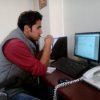Any
company trying to achieve more is constantly seeking
ways to improve employee efficiency and effectiveness, to find
techniques to help their teams work faster/smarter/better...
they're constantly seeking an edge.
Then why do so many companies stick to the 8-hour workday -- and why do so many entrepreneurs do the same thing?
Good question, and one that Leo Widrich, the co-founder of Buffer, has helped me answer. Here's our take on what's wrong with the 8-hour workday -- and how you can be a lot more productive without working longer hours.
The first thing we did when we started hiring awesome people for
the Buffer team was kill the 8-hour workday. Why? Not only did it feel
unnatural, it seemed counter-productive to what we all wanted to
accomplish in a given day.
Still, the average American works 8.8 hours every day. At least, those are the official statistics from the Bureau of Labor Statistics:

That's fine... but knowing how long the average person works every
day has little to do with knowing how efficient or productive that
workday -- and that individual's output -- may be. With all the success
stories of people working 4 hours a week to 16 hours a day it’s hard to know if there is an optimal workday.
So instead of going with my gut, I did some research on how to optimize work time for success and happiness.
Let’s dig in:
Why is there an 8 hour work day in the first place?
The typical work day is approximately 8 hours, but how did we come up with that? The answer is hidden in the birth of the Industrial revolution.
In the late 18 century companies wanted to maximize equipment usage
by running 24/7. Of course that meant people had to work more hours, so
10 to 16 hour workdays became the norm.
These incredibly long work days weren’t sustainable, though, and
soon a brave man named Robert Owen started a campaign to have people
work no more than 8 hours per day. His slogan was, “Eight hours labor, eight hours recreation, eight hours rest.”
Owen's efforts notwithstanding, it wasn’t until much later that Henry Ford actually implemented an 8-hour work day:
“One of the first businesses to implement this
was the Ford Motor Company, in 1914, which not only cut the standard
work day to eight hours, but also doubled their worker’s pay in the
process. To the shock of many industries, this resulted in Ford’s
productivity off of these same workers, but with fewer hours, actually
increasing significantly and Ford’s profit margins doubled within two
years.
This encouraged other companies to adopt the shorter, eight hour work day as a standard for their employees.”
So there it is: The reason we work 8 hours a day isn’t based on
science. It’s just a century-old practiced based on running factories
efficiently -- and is irrelevant in today's creative economy. Today the
right focus is on your energy, not your hours, according to the author Tony Schwartz, who says, “Manage your energy, not your time.”
Schwartz explains we all need to manage four different types of energies every day:
- Physical energy: How healthy are you?
- Emotional energy: How happy are you?
- Mental energy: How well can you focus on something?
- Spiritual energy: Why are you doing all of this? What is your purpose?
Machines move linearly, humans move cyclically
For an efficient work day that truly respects our human nature, the first things to focus on are ultradian cycles.
Generally speaking we can focus on any given task for 90 to 120
minutes. After that a 20-30 minute break is needed so we can recharge
and be ready to achieve high performance on our next task.
Here is a representation of the ultradian rhythm:

So instead of thinking, “What can I get done in an 8 hour day?”
I’ve started to think, “What can I get done in a 90 minute session?”
The foundation of a productive work day: Focus
Now that we know we should split everything in 90 minute chunks, it’s time to break down those 90 minutes sessions further.
In a stunning research project, Justin Gardner our brain uses a two-step process:
1.) “Sensitivity enhancement”: Start by
picturing a scene or setup and taking it all in. Then focus on what
needs your attention. Kind of like “a blurry photo that slowly starts to
come into focus,” describes Lifehacker.
2.) “Efficient selection”: This is how the actual zooming in on a task happens, allowing us to enter into what Mihály Csíkszentmihályi calls “flow” state. That's when our actual work on a task happens.
The following figure may describe it best:

In figure A, as our brain is presented with only one task, and we
are able to separate out distractors (blue) from what’s actually
important (yellow).
In figure B, as we are presented with multiple tasks at once, our
brain is increasingly easy to distract and combines the actual tasks
with distractors.
The key conclusion Gardner suggests is that we have to:
- Stop multitasking to avoid being distracted in our work environment.
- Eliminate distractors even when only one task is present
Sounds fairly obvious right? Still, doing it every day is much easier said then done. Here are some hands-on tips.
4 Tips for Improving Your Productivity
For my daily workflow at Buffer I’ve made four distinct changes to better implement the above research. Here's what works best for me:
- Manually increase the relevance of a task: It can be hard to maintain focus, especially if what you're doing doesn't have a deadline. Overriding your attention system,
and adding your own deadline together with a reward can significantly
improve task completion, according to researcher Keisuke Fukuda.
- Split your day into 90 minute windows: Instead
of thinking about an 8, 6, or 10 hour work day, split your day into
four or five 90-minute windows. That way you will have, say, four tasks
you will get done more easily.
- Plan your rest so you actually rest: “The
fittest person is not the one who runs the fastest, but the one who has
optimized their rest time,” says Tony Schwartz. A lot of the time we
are so busy planning our work day that we forget about “how” to rest.
Plan beforehand what you will do to recharge: Nap, read, meditate, get a
snack, etc.
- Allow zero notifications: One of the best ideas I’ve ever had was to follow Joel’s advice on zero notifications.
Having absolutely no alerts on my phone or computer that breaks my
focus has been a huge help. If you haven’t tried it, try to turn off
every digital element that could become an alert.
Now it's your turn: What do you think is the best way to structure your work day?
I also write for Inc.com:
 Check out my book of personal and professional advice, TransForm: Dramatically Improve Your Career, Business, Relationships, and Life -- One Simple Step At a Time. (PDF version here, Kindle version here, Nook version here.)
Check out my book of personal and professional advice, TransForm: Dramatically Improve Your Career, Business, Relationships, and Life -- One Simple Step At a Time. (PDF version here, Kindle version here, Nook version here.)
If after 10 minutes you don't find at least 5 things you can do to make your life better I'll refund your money.
That way you have nothing to lose... and everything to gain.


























